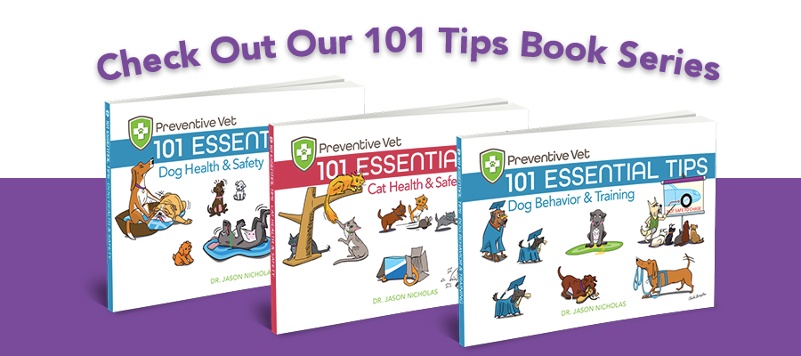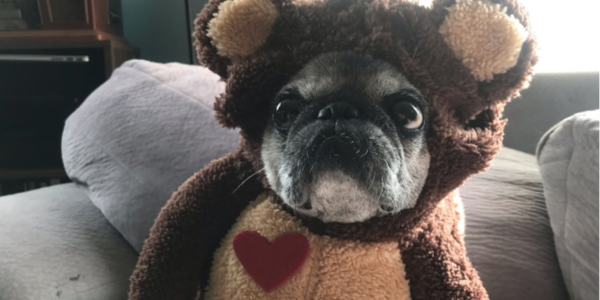 Ah, Halloween; the time of year when looking like a cast member from the Walking Dead is celebrated! And the one day when consuming mountains of chocolate is encouraged.
Ah, Halloween; the time of year when looking like a cast member from the Walking Dead is celebrated! And the one day when consuming mountains of chocolate is encouraged.
While this night may be a wonderful time for you and your two-legged kids, it's important to keep in mind that ‘All Hallows Eve’ can present some new dangers for your cats and dogs and therefore may not be as fun an evening for your four-legged kids.
As with most things though, if you’re aware of the potential Halloween hazards for cats and dogs and take the easy steps provided here, your whole family will be far more likely to have a Halloween full of fun and great memories, rather than a night (and a sizable chunk of change) spent in the local Animal ER.
To help you gear up for the ghoulish holiday, we’ve compiled the top Halloween dangers so that you can avoid a real nightmare for your dog or cat!
Cat & Dog Halloween Costumes
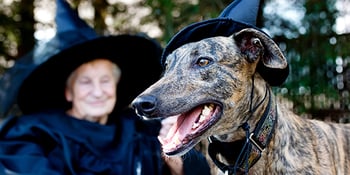 Do you like to dress your pets up for Halloween? Many people do and, depending on how much your pet enjoys it (note that many don't!), it can either be tons of fun or an utter disaster. If you decide to dress up your pets for Halloween, here are some important things for you to be aware of and do:
Do you like to dress your pets up for Halloween? Many people do and, depending on how much your pet enjoys it (note that many don't!), it can either be tons of fun or an utter disaster. If you decide to dress up your pets for Halloween, here are some important things for you to be aware of and do:
Help Your Pet Feel Comfortable in Their Costume
This is going to take some planning, as it really is important to help your pet feel comfortable in their costume way ahead of time. You can do this using "desensitization" and introducing their costume piece by piece in a positive way. You can read how to do this in our Top 5 Training Tips for Halloween article.
If your pet just isn't loving it as much as you'd hoped they would, don't force the issue. Just take off the costume and think of other ways to incorporate your pets in the Halloween festivities, your pet's stress and discomfort isn't worth it ... for anybody.
If they are tolerating it enough, you may be able to snap a few fun costumed pics of them to post on social (and feel free to share them on our Facebook page, too!) or submit to your local Pet Halloween Costume contest, but then it's time to take the costume off. No sense in forcing your stressed pet to stay in their Wonder Woman costume any longer than they want to be, no matter how utterly adorable it might otherwise be.
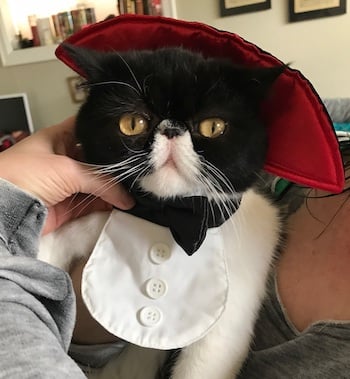
Keep an Eye on Your Pet
Don’t leave your pet unattended in their costume. Pets may be tempted to chew off loose pieces of fabric and dangling small objects (like bells and "eyes"), resulting in digestive upset or even obstruction.
This won’t be comfortable for your pet, and it may ruin your carpets and your bank account, too. (Digestive obstructions typically require surgery and/or endoscopic removal to resolve.)
Loose and dangling pieces of costume can also trip up your pet, and they might become entangled on furniture or caught in closing doors, as well. So avoid costumes with dangly bits!
Avoid Masks for Your Pet's Costume
What about masks for your pet you might ask? Hmmm … caution and pause is advised there, too. Not only are most pets cute enough without them, but many masks can obstruct your pet’s vision and/or their ability to breathe (and this is especially true with brachycephalic dogs).
Few things will distress an animal more than a sudden loss of vision or ability to breathe normally. If your pet can’t see very well, they’re also at greater risk of traumatic injuries, such as broken bones from stepping in holes or falling off curbs, as well as from being struck by a passing car.
How About Some Dye?
If you're bold enough to play beautician to your pup, be careful when choosing the dye. Make sure it's safe for your pets — you don’t want it causing skin irritation or an allergic reaction. And you don’t want it causing gastrointestinal upset or toxicity if your pet licks it off either. ‘Pet-safe’ or not, you should always avoid applying such dyes to the area around your pet’s eyes and mouth.
Read more about painting or dyeing your pet to make the outcome as safe (and adorable) as possible.
Pro Tip: If you plan on taking your pet with you for the trick-or-treating jaunt around the neighborhood (which isn't always a good idea for every dog), be sure to include some reflective or self-illuminating material on your pet’s costume.
Night visibility on the roads is always lower in the fall. Whatever you can do to increase your pet’s visibility to passing cars will help to ensure that they won’t wind up getting hit by one of them.
Dangerous Halloween Treats
Xylitol is Deadly for Dogs
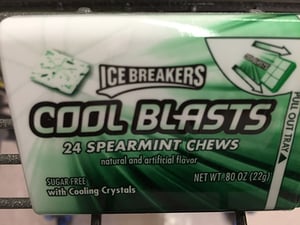
You may be thinking, why isn’t chocolate the number one danger facing your pet? It's because xylitol, a natural sugar alternative, is even more toxic to dogs than chocolate, its use is becoming increasingly common, and too many people are still unaware of the very real and serious dangers that xylitol poses to dogs.
Hard candies, sugar-free gum, and even some chocolates are just a few of the many types of products that can contain xylitol.
If you have children, make sure they don’t leave their candy lying around anywhere that’s accessible to your dog. And be sure to hang any bags or purses up where your dog truly can't reach them. Even just a small piece of gum like you would find in Ice Breakers Ice Cubes gum (which can have up to 2 grams of xylitol per piece!) contains enough xylitol to severely sicken or even kill a small dog, and it doesn’t take much more than that to pose the same danger to larger dogs.
If you’re handing out any xylitol products to trick-or-treaters, make sure they’re completely locked away from your own dogs and consider adding a little note of awareness to help protect any dogs those trick-or-treaters may have at home (feel free to print out and distribute our free xylitol & dogs awareness "poster").
Wanna be even safer, don’t give out any xylitol-containing gums, mints, or candies for Halloween. To find out which candies and other products contain xylitol, check our list of xylitol-containing candies, gums, and mints. (Fortunately, it appears to be the case that xylitol isn't toxic to cats.)
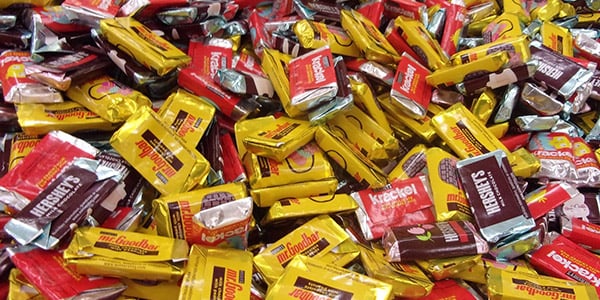
Chocolate
OK, now that we've covered xylitol, it's time for chocolate. (Mmmm ... chocolate!!) Chocolate is typically the reason behind most calls to veterinarians during this time of year. And yes, chocolate can be problematic for pets. The darker the chocolate, the more toxic and problematic it is for dogs and cats. This is because the concentration of theobromine, a caffeine-like compound found in chocolate, is higher the darker the chocolate is (i.e., the more cocoa the chocolate contains).
While many people are aware of the danger chocolate poses to dogs, the same danger for cats is far less publicized. Granted, cats are less likely to chow down on a Hershey’s, but the theobromine in chocolate is just as toxic for cats as it is for dogs. And perhaps even more so, as cats are typically much smaller than many of the dogs that do chow down on chocolate. For instance, did you know that as little as one ounce of dark chocolate is enough to require emergency veterinary care for a 10-pound cat?
For pets with pre-existing heart disease or seizure conditions, the concern is even higher, as these are two of the big “target organs” for the toxic effects of chocolate. Understanding these factors, as well as the importance of the theobromine concentration, could mean the difference between checking in with your vet if your Great Dane eats an M&M or rushing to the ER if your Corgi gets into a stash of dark chocolate bars.
And keep in mind that it’s not just the toxic effects of theobromine that makes chocolate dangerous to your pets — chocolate also has a high fat content, which can lead to digestive upset and pancreatitis, adding not just insult, but additional injury to injury.
If you haven’t already, train your dog to leave it and drop it and check out our article, “Chocolate: The Most Well-Known-About, Yet Still Common, Dog Toxin.” You can also download the APSCA’s poison control app to use their chocolate toxicity calculator.
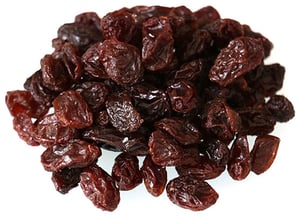 Raisins
Raisins
First, can we all agree that handing out raisins on Halloween should be a federal crime? But if anyone in your home does come back with a box of raisins, it could be more of a problem than just crappy “treats.”
If a dog (and possibly some cats) gets into them, grapes, raisins, and currants can lead to acute kidney failure. We don’t know which pets will be susceptible to the toxic effects of raisins, nor the number of raisins that must be ingested before problems are seen. So be sure to put any trick-or-treat raisins in the garbage where they rightfully belong, or at least keep them well away from your pets.
Snack and Candy Bags
The actual treats in your kid’s Halloween bounty aren’t the only potential food-related problem for your pets — the wrappers and bags those treats come in can also cause problems. Ingested candy wrappers can lead to digestive system inflammation and/or obstruction, resulting in episodes of vomiting and/or diarrhea, as well as an unplanned trip to the veterinarian, and possibly the surgery table.
Watch for the signs that your cat or dog may have ingested something that’s “stopping them up.” Signs could include vomiting, decreased energy and/or appetite, or straining to defecate.
Candy bags and salty snack (e.g., chips, pretzels, etc.) bags can also turn deadly in a matter of minutes. A dog rummaging for crumbs can easily get their head stuck in a plastic or Mylar snack bag, creating a vacuum-like seal and suffocating in just 3–5 minutes!
Once their head becomes stuck, the dog will panic, which depletes oxygen and raises carbon dioxide even faster. Regardless of the dog's size, they won't be able to get the bag off their head once it’s stuck. The same goes for candy bags that hold individual, or “fun size,” treats.
Even if they’re empty, a dog’s curious nose is more than enough to cause them to poke their head in and explore. While this is definitely more of a dog danger, there are reported cases each year of cat suffocation as well. So be aware and take precautions.
To keep your dog or cat and all other neighborhood pets safe from the dangers of suffocation, cut or tear the empty bags twice (once along the bottom and once down a side), to make it a flat sheet, and throw them away in sealed trash containers. If the trick-or-treaters in your family come back with snack bags, make sure they do the same with those as well.
Haunted House? Halloween Decor Dangers
Fake Spider Webs and Other Decorations
Both dogs and cats tend to explore new things with their mouths, and that could include your Halloween decorations. A curious cat may ingest fake spider webs or even the rubber spiders. A bored dog will do the same, as well old pumpkins, corn, or other autumnal vegetables.
Any of these common Halloween items can obstruct your dog or cat’s digestive tract (stomach and/or intestines), which requires costly and invasive surgery to remove the obstruction. At the very least, eating something like fake spider webs can leave your pets feeling pretty lousy.
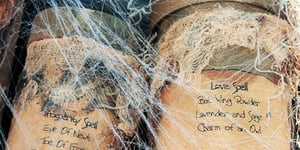
Glow sticks and glow jewelry can be as dangerous to cats as they are alluring. While the dibutyl phthalate contained inside isn’t likely to be very toxic in low doses, it can definitely be quite irritating to your cat’s skin and eyes.
This is made worse when cats groom themselves to remove the liquid, causing symptoms like drooling, gagging, and retching, according to the Pet Poison Helpline.
And don't forget to clean up those drooping jack-o-lanterns after the holiday! Spoiling pumpkins can lead to digestive upset in bored, mischievous, or curious pets that eat them. This can lead to an emergency trip to the veterinarian, as well as a big mess to clean out of your carpets.
 Electric and Power Cords
Electric and Power Cords
Do you see Halloween as an excuse to fill your home with a cacophony of flashing lights, ghoulish sounds, and other electronic decorations? If so, keep the cords covered or tucked away where your cats and dogs can’t get them.
Chewing on electric cords can result in burns to your pet’s tongue and mouth and possibly a buildup of fluid in their lungs. A bad enough electric shock can easily put your pet in the hospital for several days where they’ll rack up a few thousand dollars in vet bills. And, as if that isn’t enough to encourage caution with cords, a chewed cord can easily spark a house fire!
Candles and Flames
Hate to break it to you, but your conjuration ritual probably isn’t going to summon any actual spirits. Now that we’ve got that out of the way, go ahead and ditch the real candles (the dark lord won’t be insulted).
Curious cats and dogs can easily brush against the open flame of a candle, resulting in severe and painful burns and possibly even lighting your home on fire. And anyone with cats can verify their curiosity even in the face of flames. It takes one candle on a hearth being knocked over to start a house fire. If you want to set the mood for your Halloween séance, keep the candles flameless and opt for the LED variety instead.

Other Halloween Dangers for Pets
If you’re a popular stop on your neighborhood’s trick-or-treating route, your door is going to be blowing up on Halloween night. The constant knocking, doorbell ringing, and parade of strangers can really stress out a dog or a cat, which can lead to a reduced appetite, digestive upset, or even aggression.
Awareness and safe containment is your best bet in keeping your pet safe and lowering their stress.
Prevent Door Dashing
It’s best to keep your dog or cat in a back room of the home in their safe space where the commotion won’t bother them and to keep them from dashing out the door. You might also try placing your dog in a crate or carrier that’s filled with plenty of toys or interactive feeders and food puzzles to keep them entertained.
For cats, it’s best to always keep your furry feline indoors in the days leading up to and during the actual Halloween night festivities — there are some great food puzzles made especially for cats to keep them busy.
Aside from all the normal dangers that outdoor cats face on a daily basis, Halloween (and the even more dangerous ‘Mischief Night’ that precedes it) potentially carry with them the additional dangers of twisted kids (and sadly, adults too) intentionally traumatizing or harming cats on these nights. Though such incidences sadly occur throughout the year, there may be an increased risk associated with this holiday. Don’t take the chance – keep ‘em inside.
Halloween Leash Safety
For pets that will join you trick-or-treating around the neighborhood, keep them on a leash the whole time. Leashes save lives! A leash will not only keep your pet from bolting in front of a passing car, but it will also help you prevent them from eating dropped candy, and other potentially dangerous things from the ground. Leashes also prevent dog fights and keep spooked dogs from running off.
Pro Tip: All leashes are NOT created the same. Have a read of this article to see why Flexi® and other retractable-type leashes are a bad idea on Halloween (and on most other days).
For more tips and how-to's to have a safe and fun night of trick-or-treating, check out our Top 5 Training Tips for Halloween. Hopefully this list hasn’t completely frightened you! Using a little prevention can make every holiday a little more enjoyable and a lot less costly. Preventive Vet wishes you a Happy Halloween!


